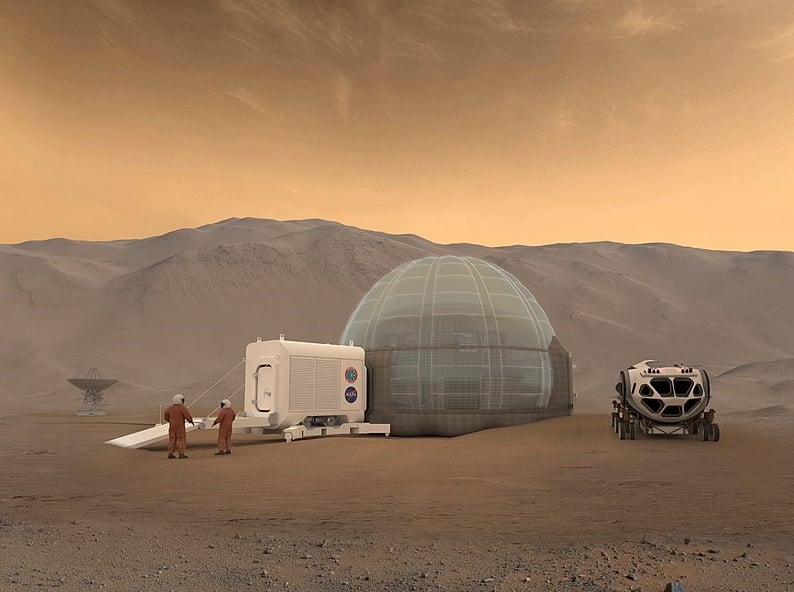
Elon Musk has long championed the campaign for bringing human beings to Mars, claiming that a colony will be established as early as five years from now, with ten years being a “worst-case scenario.”
While many scientists disagree with Musk’s timeline, they still believe that colonization is on the horizon for us. But how off is Musk, and what exactly would a relatively near-future Mars colony really entail?
Professor Serkan Saydam, who works at the School of Mineral Energy Resources Engineering at UNSW Sydney, says that a colony on the Red planet is in fact possible within the next three decades as long as autonomous forms of mining are commercially viable.
“Everything is all about water,” Saydam explains. “You use water as a life support, plus also being able to separate out the hydrogen to use as an energy source.”
“The process for having humans on Mars will be to set up operations, go there and produce water with robots first, and then be able to extract the hydrogen to make the energy ready before people arrive,” Saydam said, breaking down the preconditions for a stable colony. “Innovation in robotics and autonomous systems are clearly important so that we have the water ready and the hydrogen separated and ready for when human beings land.”
Scientists see colonization further off in the future than Musk
But Saydam is less optimistic than Musk about our civilization’s readiness to pull off such a plan at the moment despite its potential.
Saydam says that “at the moment, we don’t have the ability to do it.”
“There are significant research efforts, specifically here at UNSW under ACSER (Australian Centre for Space Engineering Research), about the best way to do it, but there is no consensus yet,” he explains. “It also depends on how many people we expect to be living on Mars. Is it five, or 5000, or 50,000, or even more?”
This deeply contradicts Musk’s outlook. The billionaire has stated that he believes a city of roughly a million inhabitants is possible by 2050 with humans first reaching the planet in “about five years, worst case [ten] years.”
Saydam believes this to be a rushed and unlikely timeline but also said that the interest in Mars colonization has the potential to accelerate the advancements required to make it possible.
“I think the technology is ready and we already have the knowledge, but the main problem is having the focus,” he explained. “It’s a bigger question: ‘Why don’t we do that already on Earth? Why are we still using human beings for physical work in mining here?’ We have huge experience in mining, but still heavily depend on humans.”
“One issue is that demand is not there,” he maintains. “For companies to get involved in developing products (for mars missions), they need to be able to produce minerals or something that can be used for manufacturing goods and then sell it. At the moment, everything is just a cost and there is no revenue for companies.”
NASA plans mission to simulate life in Mars colony
But NASA has obviously prioritized the possibility. The space agency will begin a year-long mission this fall to simulate life on Mars.
A statement from NASA clearly indicates that they are interested in cultivating readiness for the almost certain possibility that humans will be on Mars in the near future.
“As NASA ventures farther into the cosmos, the astronaut experience will change,” it was predicted. “In preparation for the real-life challenges of future missions to Mars, NASA will study how highly motivated individuals respond under the rigor of a long-duration, ground-based simulation.”
The simulated mission will have four crew members lie in a small 3D printed module that simulates the real-world environment of a Mar’s living space, challenging the crew members to deal with “resource limitations, equipment failure, communication delays, and other environmental stressors.”
What would a base on Mars actually look like?
NASA is working with Texas-based company ICON to 3D-print the Mars Dune Alpha living space for the mission, and it’s likely that an actual base on Mars would be created through the same process.
3D-printing is the go-to method for creating habitats in space because of the simple building process. Bringing too many materials to space is not an option.
Despite the simplicity of its construction, however, the base itself will be far from utilitarian. The living space will resemble the Mars bases of recent sci-fi movies like Matt Damon’s The Martian with spaces reserved for comfort and entertainment.
NASA maintains that Mars Dune Alpha will be the “highest fidelity habitat ever constructed by humans,” so it’s safe to say that the environment is likely the closest thing to what will end up existing on Mars in the future.
It is said that “Mars Dune Alpha is intended to serve a very specific purpose, to prepare humans to live on another planet.”
Musk’s plans are a little more elaborate.
“The next really big thing is to build a self-sustaining city on Mars and bring the animals and creatures of Earth there,” he said in speaking to TIME magazine for his Person of the Year cover story.
But scientists have cast doubt on this claim and the extremely ambitious date of 2028 that Musk has set, dismissing the notion as just a “brilliant sound bite.”
See all the latest news from Greece and the world at Greekreporter.com. Contact our newsroom to report an update or send your story, photos and videos. Follow GR on Google News and subscribe here to our daily email!



